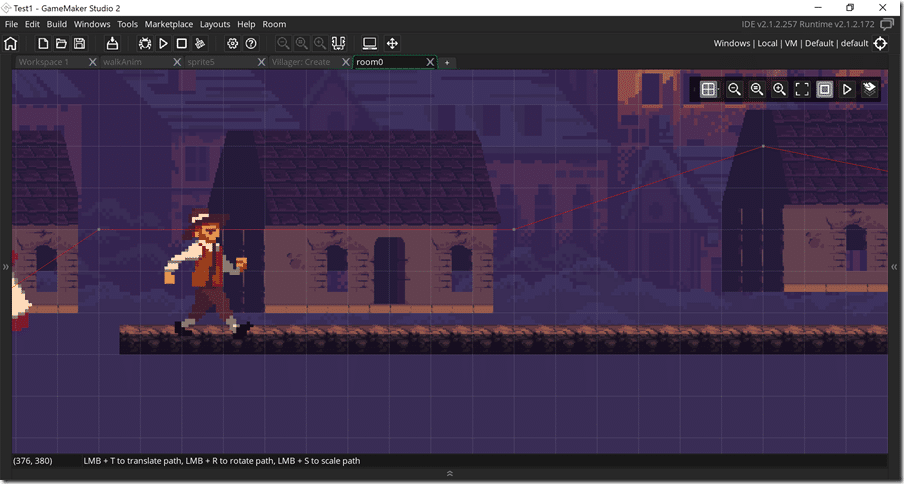Written in May 2018 by Nathan Ranney, the founder of game development studio Gutter Arcade.
A timer is a mechanism that allows you to count up, or down, to a certain value and then trigger something once that value is reached.
When starting your first GameMaker Studio 2 project, you’ll be presented with one of two choices: To make a Drag And Drop project or to make a GameMaker Language project. There are pros and cons to each, but you’ll find users will typically lean more to one than the other, at least in the beginning. GameMaker Studio is a game engine perfect for making cross-platform and multi-genre video games through drag-and-drop visual programming. It is best for 2D game development, but has limited 3D capabilities compared to other game engines like Unity or Unreal. GameMaker: Studio General Discussions Topic Details. Onion Sep 21, 2016 @ 2:57pm. Game Maker includes two types of pop-up messages: messages with game pause. Gamemaker will subtract 1 every step- meaning 60times which takes 1 second. And remember, the number we times the roomspeed by is the total number of seconds we want. Initial situation: You have a Game Maker Studio 2 project that you want to publish on GitHub. Enable source control for your project. You do this on a per-project basis by opening Options Main in the tree view on the right and enabling General Enable source control.

Gamemaker Studio 2 Free Full
So for example, let's say you have a character who has been poisoned. Poison damage is generally a damage over time status effect, that deals a small amount of damage every so often. Imagine your game runs at 60 frames per second, and you decided that poison damage should be one damage. Your character has 100 hp and your code looks like this.
Example poison code
This does not have a timer, or any sort of limitation on it, so it ticks down your hp by one every frame at 60 frames per second. Which means, your character with 100 hp dies in 1.6 seconds. What you would really want to do is tick down your poison damage every couple of frames. Maybe even every second. That code looks something like this.
Example poison timer code
In this example, I am using a new variable, poisonTick, to determine when to apply poison damage. So now, what took 1.6 seconds previously, takes 100 seconds. poisonTick counts down by one every frame. Once poisonTick reaches 0, the player hp is reduced by the poisonDamage value, and poisonTick is reset back to its maximum of 60. This requires slightly more management than using alarms, but is much more versatile.
To use timers in this way, you need at least one variable, which is the variable that stores whatever you are counting. In the above example that is poisonTick. I would highly recommend a second variable to use when you reset your counted variable. This makes it much easier to manage. I'll go over this in an example below.
More Examples
Another benefit to using manual timers is you can use the same timer variable in multiple cases. I often use a variable called actionDur (action duration) in my games to determine how long any one character action can be performed. Let's say a character has two actions, attack and dash, both of which are timer dependent. The character is locked into either action for the duration of the timer. You could use two timers to manage this, like attackDur and dashDur. Or you can use a single timer, and use it in both places. See the example below.



Multi-use timer
As you can see, both actions are able to use the same timer variables. Be aware that if you are using the same timer variable in multiple places, each use of the timer has to be completely independent of the other uses. So, using the above example again, I have to make sure that attack and dash cannot be true at the same time. If both variables were ever true at the same time, actionDur would countdown twice as fast. I highly recommend setting up a state machine for your character which will help you manage what code is running when.
You can also count up with your timers, which changes the structure slightly. It is somewhat personal preference whether you choose to count up or down. You may run into some cases where counting up or down is more beneficial than the alternative.
Timer counting up

Gamemaker Studio 2 Tileset Collisions
There are some slight differences here. Our timer starts at 0, rather than the max, and counts up towards the max.
So what happens if you want to use a single timer for multiple actions, but have those action durations differ? The easiest way to do this, if you are using the same kind of setup that I've been talking about, is to define the starting point of your timer when the action happens. Using the attack action again, let's see how that might work.
Different timer duration with a single timer variable
Gamemaker Studio 2 Games
In this example, we had to make use of a new block of code. We've added the attack_button variable, which you can imagine is a player pushing the attack button in a game. When that button is pressed, attack becomes true, and actionDur is set to 30. By default, actionDur is set to 0, and we are overriding that when pressing our imaginary attack button. However, actionDur is still counting up to the actionDurMax when attack is set to true. Only this time, instead of starting from 0, it starts from 30. This effectively halves the duration of our attack action. Here is another example using a second action.
Multiple actions with different timer durations
Though it requires a bit more management than using alarms, using timers is a much more flexible and transparent setup.
